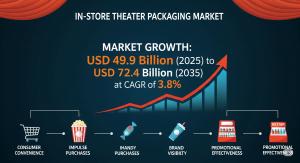The Future of Retail is in the Packaging: How In-Store Theater is Driving Sales and Brand Loyalty
Manufacturers leverage in-store theater packaging to influence shoppers, driving growth toward a projected USD 72.4 billion market by 2035.
NEWARK, DE, UNITED STATES, August 20, 2025 /EINPresswire.com/ -- In an evolving retail environment where every inch of shelf space is a battleground for consumer attention, a new form of packaging is taking center stage. The In-Store Theater Packaging Market, estimated at USD 49.9 billion in 2025, is on a remarkable growth path, projected to reach USD 72.4 billion by 2035 with a compound annual growth rate (CAGR) of 3.8%. This growth signifies more than just an increase in value; it represents a strategic shift by manufacturers to leverage packaging as a high-impact point-of-sale tool, designed to captivate and convert.
This compelling market momentum is rooted in the packaging’s unique ability to merge structural functionality with visual appeal, creating a "theater" that tells a brand’s story and enhances the shopper experience. In-store theater packaging is not just a container; it's a dynamic display that elevates brand visibility and recall, directly influencing purchasing decisions in a highly competitive retail space. As physical stores adapt to the rise of omnichannel commerce, this packaging solution is becoming a critical component of brand differentiation.
Request In-Store Theater Packaging Market Draft Report: https://www.futuremarketinsights.com/reports/sample/rep-gb-4467
Strategic Insights for Manufacturing Innovation
The market’s growth is shaped by key trends that offer manufacturers a clear pathway to success. These include a growing emphasis on sustainable materials, advancements in printing technology, and a focus on creating a seamless supply chain from factory to shelf.
- The Paperboard Revolution: The paperboard segment is the undisputed leader, projected to hold a commanding 57.6% of the market in 2025. This dominance is driven by its alignment with the global push for sustainability. As consumers and regulations favor recyclable and biodegradable options, paperboard offers a lightweight, highly printable, and cost-effective solution. Its adaptability to diverse structural designs allows for the creation of impactful, visually engaging displays that don't compromise on environmental standards. For manufacturers, investing in paperboard solutions means meeting consumer demand for eco-conscious products while simultaneously benefiting from enhanced production technologies in die-cutting and embossing, which enable high-quality, large-scale production.
- Retail is the Main Stage: The retail and consumer segment is the largest end-use category, expected to account for 42.9% of the market's revenue in 2025. This is where the power of in-store theater is most evident. In supermarkets, hypermarkets, and specialty stores, this packaging is used to create immersive shopping experiences that draw consumer attention and stimulate impulse buys. For manufacturers, this segment represents a significant opportunity to improve shelf management and reduce restocking efforts with display-ready units. By designing packaging that is both aesthetically pleasing and functional, brands can streamline their supply chain while enhancing product presentation.
A Market Poised for Continued Expansion
The historical and future outlook for the in-store theater packaging market points to sustained growth, driven by its undeniable value proposition. The packaging provides store owners with extra merchandising space that is both compact and easy to maintain, directly addressing a key pain point for retailers. This convenience, combined with the packaging's ability to boost brand visibility and sales, makes it a powerful tool for both manufacturers and retailers.
While challenges like higher pricing and competition from conventional alternatives exist, the market is mitigating these through innovative features. The incorporation of elements like LCD screens, sound systems, and interactive components are key trends that are further enhancing brand visibility and creating unique consumer experiences.
For more on their methodology and market coverage, visit! https://www.futuremarketinsights.com/about-us
From a regional perspective, the growth is widespread. North America currently leads the market, propelled by the high density of supermarkets and a strong retail sector. Europe is also experiencing steady growth, driven by a burgeoning middle class with increasing disposable income. The Asia Pacific region is anticipated to see similar growth, fueled by rising demand from the retail and consumer segments.
Ultimately, the in-store theater packaging market is defined by its ability to offer a comprehensive solution for manufacturers. It addresses the core challenges of brand differentiation, supply chain efficiency, and sustainability, all while creating a memorable and engaging experience for the end consumer. As brands like Smurfit Kappa Group, Cepac Limited, and Interprint continue to innovate, the stage is set for in-store theater packaging to play an even more significant role in the future of retail.
Related Reports:
India Steel Drum & IBC Market: https://www.futuremarketinsights.com/reports/india-steel-drum-and-ibc-market
North America Bulk Aseptic Packaging Market: https://www.futuremarketinsights.com/reports/north-america-bulk-aseptic-packaging-market
Australia & New Zealand Molded Fiber Pulp Packaging Market: https://www.futuremarketinsights.com/reports/australia-and-new-zealand-molded-fiber-pulp-packaging-market
Editor’s Note:
This release is based exclusively on verified and factual market content derived from industry analysis by Future Market Insights. No AI-generated statistics or speculative data have been introduced. This press release highlights significant shifts in the In-Store Theater Packaging Market, which is experiencing a pivotal change driven by consumer demand for healthier, more transparent products.
Rahul Singh
Future Market Insights Inc.
+18455795705 ext.
email us here
Visit us on social media:
Other
Legal Disclaimer:
EIN Presswire provides this news content "as is" without warranty of any kind. We do not accept any responsibility or liability for the accuracy, content, images, videos, licenses, completeness, legality, or reliability of the information contained in this article. If you have any complaints or copyright issues related to this article, kindly contact the author above.
Reverse Med Bar Introduces the Matrix® Skin Renewal Platform: A Revolutionary Approach to Skin Health
GenH2 Senior Technology Advisor Honored with Prestigious NASA Recognition
Mary-Beth Newell Reveals the Secrets to Youthful Living with 'Anti-Aging and Secrets of Healthy Living to Stop the Clock!'
Więcej ważnych informacji
 Jedynka Newserii
Jedynka Newserii

 Jedynka Newserii
Jedynka Newserii

Finanse

K. Gawkowski: Polska w cyfrowej transformacji gospodarki awansowała do pierwszej ligi w Europie. 2,8 mld zł z KPO jeszcze ten proces przyspieszy
Uruchomiony na początku lipca przez Ministerstwo Cyfryzacji i BGK program „KPO: Pożyczka na cyfryzację” cieszy się dużym zainteresowaniem. Samorządy, uczelnie oraz firmy mogą wnioskować o wsparcie finansowe dla inwestycji w transformację cyfrową, m.in. modernizację infrastruktury czy cyberbezpieczeństwo. W sumie na ten cel trafi 2,8 mld zł (650 mln euro). Ze względu na krótki czas naboru obie instytucje organizują w poszczególnych województwach warsztaty dla wnioskodawców, które mają rozwiać ich wątpliwości przy przygotowywaniu wniosków.
Prawo
Koszty certyfikacji wyrobów medycznych sięgają milionów euro. Pacjenci mogą stracić dostęp do wyrobów ratujących życie

Od 2027 roku wszystkie firmy produkujące wyroby medyczne w Unii Europejskiej będą musiały posiadać certyfikat zgodności z rozporządzeniem MDR (Medical Devices Regulation). Nowe przepisy wprowadzają dużo ostrzejsze wymagania w zakresie dokumentacji, badań klinicznych oraz procedur certyfikacyjnych. Branża ostrzega, że część małych i średnich producentów nie zdąży się dostosować. Problemem jest także wysoki koszt i długi czas uzyskiwania certyfikatów. W konsekwencji z rynku mogą zniknąć urządzenia ratujące życie.
Infrastruktura
Nowe przepisy o ochronie ludności cywilnej wprowadzają obowiązkowe elastyczne zbiorniki na wodę. Mają one służyć w razie suszy, pożarów czy wybuchu wojny

Samorządy będą musiały posiadać m.in. elastyczne zbiorniki na wodę pitną i przenośne magazyny wody przeciwpożarowej. To element odpowiedniego przygotowania zasobów na wypadek sytuacji kryzysowych, kataklizmów czy wybuchu konfliktu, wprowadzony nowymi przepisami o ochronie ludności. Eksperci podkreślają, że tego typu rozwiązania to innowacyjne produkty, które nie tylko ułatwiają logistykę w sytuacjach kryzysowych, ale także mogą znacząco skrócić czas reakcji służb ratunkowych.
Partner serwisu
Szkolenia

Akademia Newserii
Akademia Newserii to projekt, w ramach którego najlepsi polscy dziennikarze biznesowi, giełdowi oraz lifestylowi, a także szkoleniowcy z wieloletnim doświadczeniem dzielą się swoją wiedzą nt. pracy z mediami.








.gif)

 |
| |
| |
|